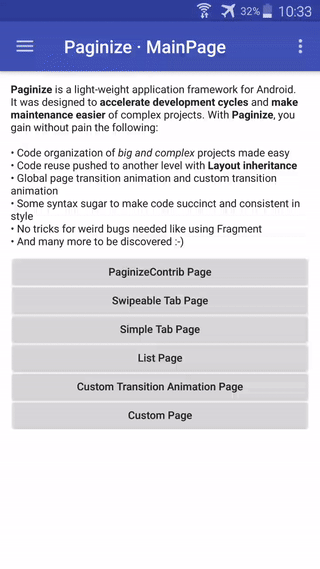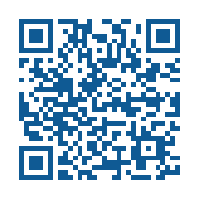Paginize
Scan the QRCode to install the demo APK and get a feel of how it works!
Description
Paginize is a light-weight application framework for Android. It was designed to accelerate development cycles and make maintenance easier, it provides an intuitive programming model for writing Android applications. Paginize models a screen as a Page or part of the screen as an InnerPage, which in essence are just view wrappers. Paginize breaks down complex user interfaces into smaller units, provides APIs for easily handling page navigations, and offers flexibility for page inheritance and layout inheritance, which pushes code reuse in Android to another level.
Installation
compile 'net.neevek.android:paginize:0.6.13' To to make your life easier, some useful implementations( BasePage? OptionMenuPage, etc.) are provided, include the following dependency to use it. The following dependency is not required to use Paginize itself. See the demo for details.
compile 'net.neevek.android:paginize-contrib:0.0.1' Documentation
- Getting started
- The lifecycle callbacks
- Paginize annotations
- Argument passing between pages
- Proguard rules
- Create a layout file(res/layout/page_frame.xml) for FramePage:
<!-- for brevity, referenced resources are not shown here. see the demo--> <?xml version="1.0" encoding="utf-8"?> <android.support.design.widget.CoordinatorLayout
xmlns:android="http://schemas.android.com/apk/res/android"
xmlns:app="http://schemas.android.com/apk/res-auto"
android:layout_width="match_parent"
android:layout_height="match_parent"
android:fitsSystemWindows="true"
android:background="#fff"
>
<android.support.design.widget.AppBarLayout
android:id="@+id/appBar"
android:layout_width="match_parent"
android:layout_height="wrap_content"
android:theme="@style/ThemeOverlay.AppCompat.Dark.ActionBar"
>
<android.support.v7.widget.Toolbar
android:id="@+id/tb_header_bar"
android:layout_width="match_parent"
android:layout_height="?attr/actionBarSize"
app:popupTheme="@style/ThemeOverlay.AppCompat.Light"
/>
</android.support.design.widget.AppBarLayout>
<FrameLayout
android:id="@+id/layout_content_container"
android:layout_width="match_parent"
android:layout_height="match_parent"
app:layout_behavior="@string/appbar_scrolling_view_behavior"
/>
<ViewStub
android:id="@+id/stub_loading_layout"
android:layout="@layout/layout_loading"
android:inflatedId="@+id/layout_loading"
android:layout_width="match_parent"
android:layout_height="match_parent"
android:layout_marginTop="?attr/actionBarSize"
/>
<ViewStub
android:id="@+id/stub_error_layout"
android:layout="@layout/layout_error"
android:inflatedId="@+id/layout_error"
android:layout_width="match_parent"
android:layout_height="match_parent"
android:layout_marginTop="?attr/actionBarSize"
/> </android.support.design.widget.CoordinatorLayout>- Create FramePage, this page will be inherited by other pages that need a ToolBar
@PageLayout(R.layout.page_frame) public abstract class FramePage extends Page {
@InjectView(R.id.tb_header_bar)
private Toolbar mTbToolbar;
public FramePage(PageActivity pageActivity) {
super(pageActivity);
if (getContext().getPageCount() > 0) {
ToolbarHelper.setNavigationIconEnabled(mTbToolbar, true, new View.OnClickListener() {
@Override
public void onClick(View v) {
onNavigationIconClicked(v);
}
}
);
}
}
protected final void setupMenu(@MenuRes int menuResId) {
ToolbarHelper.setupMenu(mTbToolbar, menuResId, new Toolbar.OnMenuItemClickListener() {
@Override
public boolean onMenuItemClick(MenuItem item) {
return FramePage.this.onMenuItemClick(item);
}
}
);
}
protected void onNavigationIconClicked(View v) {
hide(true);
}
protected boolean onMenuItemClick(MenuItem item) {
return false;
}
protected final Toolbar getToolbar() {
return mTbToolbar;
}
}
- Create another layout(page_test.xml) for TestPage, this page contains only a TextView:
<TextView
xmlns:android="http://schemas.android.com/apk/res/android"
android:id="@+id/tv_content"
android:layout_width="fill_parent"
android:layout_height="fill_parent"
android:gravity="center"
android:padding="10dip"
/>- Create TestPage:
// here we inherit the layout from FramePage, i.e. R.layout.page_frame, // insert R.layout.page_test into the R.id.container element of the parent // layout. Since we subclass FramePage, we also inherit the code for handling // the BACK button press @InsertPageLayout(value = R.layout.page_test, parent = R.id.layout_content_container) public class TestPage extends FramePage {
@InjectView(R.id.tv_content)
private TextView mTvContent;
public TestPage(PageActivity pageActivity) {
super(pageActivity);
mTvContent.setText("Hello Paginize!");
}
}
After the steps above, TestPage is a page that contains a ToolBar. As you can see, we don't need to repeat the boilerplate code for setting up the views of FramePage. Page inherited, its layout is inherited as well.
- Create an Activity that extends PageActivity, and show the TestPage:
@InjectPageAnimator(SlidePageAnimator.class) public class MainActivity extends PageActivity {
@Override
public void onCreate(Bundle savedInstanceState) {
super.onCreate(savedInstanceState);
// pass true to animate the transition
new TestPage(this).show(true);
}
}
That's all for using Paginize to make a one screen application. Here you may find that it is sort of more hassle than just use Activity, but Paginize is extremely useful when you use it to make more complicated applications, you see the advantages of it when you use it to structure a real application.
Page (including Page and InnerPage) subclasses ViewWrapper, lifecycle methods are declared in this class:
- onShow()
- The page is ready to be shown, but not yet attached to the view hierarchy
- onShown()
- The page is shown, i.e. it is pushed onto the page stack, attached to the view hierarchy, and if an animation transition is involved, this method is called when the animation finishes.
- onCovered()
- When a new page is about to be pushed onto the stack, this method is called for the previous page.
- onUncovered()
- This method is called for the previous page right before
onShownbeing called for the new page.
- This method is called for the previous page right before
- onHide()
- The page is ready to be hidden, i.e., it is about to be popped out from the page stack.
- onHidden()
- The page is hidden, i.e., it is popped out from the page stack, detached from the view hierarchy.
When a page is popped, it is ready be to garbage collected, because for most cases no one references the page at this point, but you could, that means if you keep a reference to the page, you can call show()/hide() pair multiple times to reuse the page. And that is why the method is named onHidden() instead of onDestroy(), because the framework will not know whether it is destroyed.
Besides the lifecycle methods introduced by the framework, Paginize mirrors most of the Activity lifecycle methods, for example, when onResume() is called for the current Activity, Paginize passes the method call to the top page(the currently showing page), same for methods like onPause(), onActivityResult(), etc.
Paginize takes advantage of Java Annotations to make use of the framework easier, and make features like layout inheritance possible. Some of the annotations are just syntax sugar to make the code more consistent when using Paginize.
@PageLayout- Annotated on pages, specifies a layout resource id for the current page.
@InsertPageLayout- Used in layout inheritance, annotated on pages, specifies a layout resource id to be inserted into the inherited layout, there is an optional
parentfield which can specify a parent element for the inserted layout. if theparentfield is omitted, the inserted layout will be added as the last element(s) of the inherited layout. Note, the layout specified for this annotation can be enclosed with the<merge>tag.
- Used in layout inheritance, annotated on pages, specifies a layout resource id to be inserted into the inherited layout, there is an optional
@InnerPageContainerLayoutResId- Annotated on pages that subclass
ContainerPage, which is normally used to implement tabbed UI(forget about TabHost :). This annotation specifies resource id(normally a ViewGroup or subclass of ViewGroup) in the layout specified with@PageLayout, regardless of whether it is specified directly or inherited. In the current container page, you can callsetInnerPage()to insert anInnerPage, which will be added to the layout element specified by this annotation.
- Annotated on pages that subclass
@InjectView- Annotated on views declared in page, for most cases, the injection happens when the page is instantiated, but if you set the
lazyfield totrue, injection may be triggered when thelazyInitializeLayout()method is called. This annotation also haslistenerTypesandlistenerfields to support setting listeners for the injected view.
- Annotated on views declared in page, for most cases, the injection happens when the page is instantiated, but if you set the
@ListenerDefsand@SetListeners@ListenerDefsshould be annotated on page constructors, it contains an array of@SetListeners, which is introduced to support setting up listeners for views in one place, make all Paginize-powered code consistent. It is normally used when you only want to setup listeners for the views, but do not need to keep references to the views, besides that,@SetListenersis same as@InjectView.
@InjectPageAnimator- Annotated on Activity that subclasses
PageActivity, offers page transition animation for page push/pop.PageAnimatorcan be customized, simply subclassPageAnimatorand override the required methods to create your own page transition animation.
- Annotated on Activity that subclasses
@ListenerMarker- Annotated on listener class used for the
listenerfield of@InjectViewor@SetListeners, this annotation is introduced to prevent the listener class from being obfuscated by proguard. Note, add a rule in proguard-project.txt to make this annotation take effect.
- Annotated on listener class used for the
#### 4. Argument passing between pages
For passing arguments to a newly created page, use getBundle, and set arguments in the returned bundle. Paginize will save the bundle associated with each Page during onSaveInstanceState, and restore it during onRestoreInstanceState, which means no extra work needed for saving and restoring arguments during page recreation, the bundle will be ready in onShow and lifecycle methods after that. For navigating back from a page, onUncover() and onUncovered() can be used to receive arguments from the popped page, these two methods take an object as argument, which is passed from the top page set with setReturnData() before it is popped from the page stack.
To prevent annotated classes and fields from being stripped away, the following rules must be put in proguard-project.txt.
-keep public class net.neevek.android.lib.paginize.** -keep @net.neevek.android.lib.paginize.annotation.ListenerMarker class ** {
*;
}
-keepclassmembers,allowobfuscation class ** {
@net.neevek.android.lib.paginize.annotation.** <fields>;
}
Note
The project is still NOT stable, APIs may change(but not significantly).
For more, check out the demo project.
Contributing
Please fork this repository and contribute back using pull requests.
Under MIT license
Copyright (c) 2014 neevek <i@neevek.net> See the file license.txt for copying permission. 
